The management of moisture inside the
Functional Protective Eye Mask is a vital issue of ensuring consumer comfort, in particular in situations where there may be ability sweating or publicity to humidity.
Breathable and Moisture-Wicking Fabrics:
The materials used within the creation of the attention mask regularly consist of breathable and moisture-wicking fabric. These fabrics are designed to permit air flow and facilitate the evaporation of moisture, helping to preserve the location around the eyes dry.
Microfiber or Performance Fabrics:
Microfiber or overall performance fabrics with moisture-wicking homes are commonly hired within the part of the eye masks that comes into contact with the pores and skin. These fabrics efficiently pull moisture faraway from the skin, stopping the buildup of sweat.
Strategic Placement of Padding:
If the attention mask capabilities foam padding or cushioning, the position of those factors is frequently strategic. Padding may be strategically placed to avoid trapping moisture and to sell airflow, making sure that the location around the eyes stays dry.
Ventilation Openings or Design:
Some eye masks incorporate ventilation openings or a selected layout that promotes airflow. These features facilitate the alternate of air, stopping the buildup of heat and moisture, in particular in regions in which the masks comes into contact with the face.
Perforated or Mesh Materials:
Certain components of the eye masks, inclusive of the regions across the eyes or the padding, may also contain perforated or mesh materials. These substances allow for enhanced breathability and help in moisture control with the aid of permitting air to flow into.
Hydrophobic Coatings or Treatments:
Hydrophobic coatings or remedies can be implemented to the outer layer of the attention mask. These coatings repel water and moisture, stopping the masks from soaking up sweat or humidity. This is in particular beneficial in maintaining the integrity of the substances.
Moisture-Resistant Inner Lining:
The internal lining of the eye mask, which comes into direct contact with the pores and skin, may be constructed with moisture-resistant materials. This enables in preventing the transfer of moisture to the skin and enhances the overall comfort of the user.
Absorbent Layers Away from the Skin:
If absorbent layers are included into the eye mask layout, they may be typically located faraway from direct touch with the pores and skin. This prevents moisture from being trapped near the eyes, lowering the chance of soreness.
Antimicrobial or Odor-Resistant Properties:
Some eye masks consist of antimicrobial or smell-resistant houses of their substances. These features now not only make contributions to typical hygiene but also assist manipulate moisture by minimizing the capacity for bacterial boom that may be associated with sweat.












